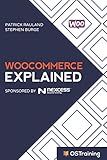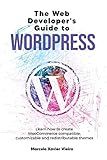Best WooCommerce Database Guides to Buy in December 2025

WooCommerce Explained: Your Step-by-Step Guide to WooCommerce



The Ultimate WordPress & WooCommerce Handbook: From Setup to Success in Online Selling



WordPress WooCommerce: Tienda online con WooCommerce (Spanish Edition)



ECOMMERCE BIBLE: The Ultimate Guide of e-Commerce, Shopify, WooCommerce, Dropshipping, Amazon FBA



The Web Developer's Guide to WordPress: Learn how to create WooCommerce compatible, customizable and redistributable themes



E-Commerce Blueprint: How to Build an Online Store in 2025: Future-Proof Your Business: A Step-by-Step Guide to Launching and Scaling a Profitable Online Store


The WooCommerce store settings in the database are stored within the "wp_options" table. This table contains key-value pairs of various settings and configurations for WordPress and its plugins, including WooCommerce.
To locate the WooCommerce store settings specifically, you can look for options with the "option_name" column containing the "woocommerce_" prefix. These options store a wide range of information such as general store settings, tax settings, shipping zones, payment gateways, email notifications, and more.
Examples of some WooCommerce store settings stored in the database include "woocommerce_currency", "woocommerce_store_address", "woocommerce_default_country", "woocommerce_tax_enabled", "woocommerce_enable_shipping_calc", "woocommerce_checkout_page_id", and so on.
Each setting is associated with a specific value which represents the configured option. Updating these values directly in the database can alter the behavior and appearance of the WooCommerce store. However, it is recommended to make changes to the settings via the WooCommerce admin interface or by utilizing specific hooks and functions provided by WooCommerce to maintain data integrity and avoid potential issues.
How to add custom fields to the WooCommerce store settings table in the database?
To add custom fields to the WooCommerce store settings table in the database, you can use the following steps:
- Determine the specific table where you want to add the custom field. In WooCommerce, the store settings are stored in the wp_options table.
- Identify a unique name for your custom field. Prefixing the field name with an identifier specific to your plugin or theme is recommended to avoid conflicts with other plugins or themes.
- Choose an appropriate hook to add your custom field to the store settings page. One common option is the woocommerce_admin_field_{$type}_{$name} filter hook, where $type is the field type (e.g., text, checkbox) and $name is your custom field name.
- Write a function to handle the custom field creation. Sample code for adding a text field named "custom_text_field" to the store settings table might look like this:
function add_custom_field_to_settings_table() { woocommerce_admin_fields_custom_text_field(array( 'type' => 'text', 'id' => 'custom_text_field', 'title' => __('Custom Text Field', 'your-plugin-domain'), 'desc' => __('This is a custom text field.', 'your-plugin-domain'), 'default' => '', 'desc_tip' => true, )); } add_action('woocommerce_admin_field_text_custom_text_field', 'add_custom_field_to_settings_table');
- Save the custom field value to the database. When saving the store settings, WooCommerce will automatically save the value of your custom field to the wp_options table.
These steps should help you add a custom field to the WooCommerce store settings table in the database. Remember to adjust the code according to your specific requirements and use proper coding practices.
How to modify store settings using the database?
To modify store settings using a database, you can follow these steps:
- Connect to the database: Use a database management system and connect to the relevant database where the store settings are stored.
- Identify the store settings table: Determine the table that holds the store settings. It could be a specific table dedicated to store settings or a more general settings table.
- Retrieve the current store settings: Fetch the existing store settings from the database table.
- Modify the desired settings: Make the necessary changes to the retrieved store settings. This can be done programmatically based on user inputs or any other predefined criteria.
- Update the database: Update the modified store settings in the database table. Use an update query to modify the relevant rows or fields in the table.
- Verify the changes: Confirm whether the database has been updated correctly with the modified store settings. Retrieve the updated store settings from the database and compare them with the changes made in step 4.
This process can vary depending on the specific database management system and programming language you are using. Ensure that you have the necessary access privileges to perform modifications in the database.
How to optimize WooCommerce store settings for better performance?
Optimizing your WooCommerce store settings can significantly improve its performance. Here are some steps to follow:
- Enable Caching: Use a caching plugin like WP Rocket or W3 Total Cache to generate static HTML files of your web pages. This reduces the server load and improves load times.
- Image Optimization: Compress your images to reduce their file size without sacrificing quality. You can use plugins like Smush or EWWW Image Optimizer to automatically optimize your images.
- Disable Unused Features: WooCommerce offers various features that you may not need. Disable any unnecessary features from the WooCommerce settings, such as reviews, product ratings, or related products.
- Limit Products per Page: Displaying a large number of products per page can slow down your store. Limit the number of displayed products per page in WooCommerce settings.
- Optimize Your Database: Use a plugin like WP-Optimize or WP Sweep to clean up your database by removing unnecessary data, optimizing tables, and reducing the database size.
- Use a Content Delivery Network (CDN): CDN stores your static content on multiple servers worldwide, reducing latency and improving load times globally. Popular CDN services include Cloudflare and StackPath.
- Choose a Lightweight Theme: Select a lightweight and optimized theme specifically designed for WooCommerce. A lightweight theme will load faster and have better performance.
- Reduce HTTP Requests: Minimize the number of HTTP requests by reducing the number of external scripts and stylesheets being loaded on your website. Combine and minify CSS and JavaScript files.
- Enable Lazy Loading: Lazy loading allows your web page to only load images and media when they are visible on the screen. This significantly improves initial load times.
- Optimize Checkout Process: Simplify your checkout process by minimizing the number of steps and required fields. Use a one-page checkout plugin like WooCommerce One Page Checkout to streamline the process.
Remember to regularly test your store's performance using tools like GTmetrix or Google PageSpeed Insights to monitor the impact of optimizations and make further improvements.
How to automate the backup process for WooCommerce store settings in the database?
To automate the backup process for WooCommerce store settings in the database, you can follow these steps:
- Identify the database tables used by WooCommerce: WooCommerce stores its settings and other data in various database tables. The main tables to consider for backup are wp_options, wp_postmeta, and wp_woocommerce_*.
- Choose a backup method: There are multiple ways to automate database backups, including using plugins, implementing code scripts, or using third-party backup services. a. Plugins: There are several backup plugins available for WordPress that can automate the process for you. Some popular options include UpdraftPlus, BackupBuddy, and WPvivid Backup Plugin. b. Code scripts: If you prefer to handle the backup process programmatically, you can write custom code using the WordPress Cron API. This approach allows you to schedule regular backups and specify the backup destination (e.g., local or remote server, cloud storage). c. Third-party backup services: You can also use external backup services like VaultPress (Jetpack Backup) or BlogVault, which offer automated backups and restoration services specifically for WordPress sites.
- Configure backup settings: Once you choose a method, configure the backup settings according to your needs. Determine the backup frequency (daily, weekly, monthly) and the retention period (how long to keep backups).
- Exclude unnecessary data: While backing up WooCommerce store settings, consider excluding unnecessary data like cache files, logs, session data, and other non-essential files or folders. This will help reduce backup size and optimize the process.
- Test backups and restoration: It is important to periodically test your backups to ensure they are working correctly. Verify that backup files are created and can be restored successfully.
- Store backups securely: Make sure to store your backups in a secure location. If using a plugin or third-party service, follow their recommended storage options. If using a code script, consider encrypting and storing backups in a separate, secure location (e.g., cloud storage, dedicated server).
- Monitor backup process: Regularly monitor the backup process to ensure it runs smoothly without any errors or inconsistencies. This will help you identify and resolve any issues promptly.
Remember to always have multiple backup copies, regularly update your backup solution, and keep track of the changes you make during WooCommerce updates or modifications to avoid potential data loss.
How to disable or enable specific store settings directly in the database?
To disable or enable specific store settings directly in the database, follow these steps:
- Access your database management tool (e.g., phpMyAdmin or MySQL Workbench) and connect to your store database.
- Identify the table that stores the store settings. This table may have a name like "store_settings" or "configuration". If you're not sure about the table name and structure, you can check your store's documentation or ask the developer or support team.
- Select the target table and browse its content to locate the specific setting you want to disable or enable.
- Look for the column related to the setting you want to modify. For example, if you want to enable/disable a feature named "enable_feature", search for a column named "enable_feature" or similar.
- Update the value in the row corresponding to the setting you want to change. Set the value to "1" or "0" to enable or disable the feature, respectively. If it's a multi-option setting, you may need to refer to a documentation or an existing enabled/disabled setting to determine the appropriate value.
- Once you've updated the value, save the changes by hitting the "Save" or "Submit" button in your database tool.
- Verify the changes by visiting the store and checking if the specific setting is now enabled or disabled as desired.
It's important to exercise caution when directly modifying the database, as any mistakes can lead to issues in your store. Make sure to create a backup of your database before making any changes and consult with a developer or support team if you're unsure about the process.
How to change the priority of WooCommerce store settings in the database?
To change the priority of WooCommerce store settings in the database, you can follow these steps:
- Take a backup: Before making any changes to the database, it's always recommended to take a backup to avoid any data loss or potential issues.
- Access the database: Use a tool like phpMyAdmin or any other database management tool to access your WordPress database.
- Locate the 'wp_options' table: In the database, locate the 'wp_options' table (the prefix 'wp_' may vary depending on your WordPress installation).
- Find the relevant option: Look for the option_name field that contains the relevant setting you want to change the priority for. For WooCommerce settings, the option_name might start with 'woocommerce_', followed by the specific setting name.
- Update the option_value field: Locate the row with the desired option_name, and then modify the option_value field. Change the priority number to a higher or lower value as desired. Lower numbers indicate higher priority.
- Save the changes: After updating the option_value field, save the changes in the database.
- Clear WooCommerce caches: To ensure the changes take effect, clear any WooCommerce caches. This can typically be done by going to WooCommerce > Status > Tools, and clicking on the "Clear transients" button or any similar option available.
That's it! The priority of the specific WooCommerce store setting in the database should now be changed, and it should take effect accordingly.
What is the data type used for storing store settings in the database?
The data type used for storing store settings in a database can vary depending on the specific database management system being used. However, common data types that can be used for storing store settings include:
- VARCHAR or TEXT: These data types can store a string of characters and are commonly used to store settings such as store name, address, or description.
- BOOLEAN: Used to store settings that require a true or false value, such as enabling or disabling certain features of the store.
- INTEGER: Used to store numeric settings like the currency code, store ID, or the number of products per page.
- JSON or BLOB: Some databases support storing structured data in formats like JSON or binary large objects (BLOBs), which can be useful for storing complex store settings or configurations.
It's important to note that the specific choice of data type may depend on the requirements of the store and the capabilities of the database management system.
